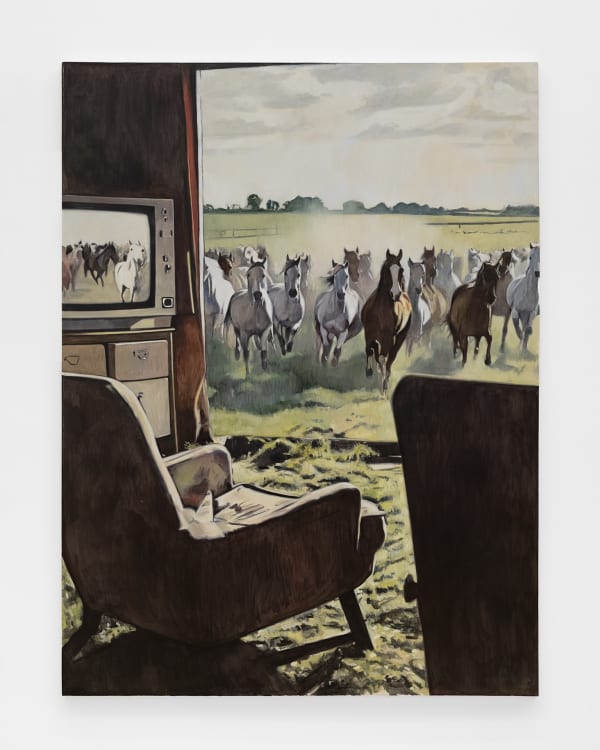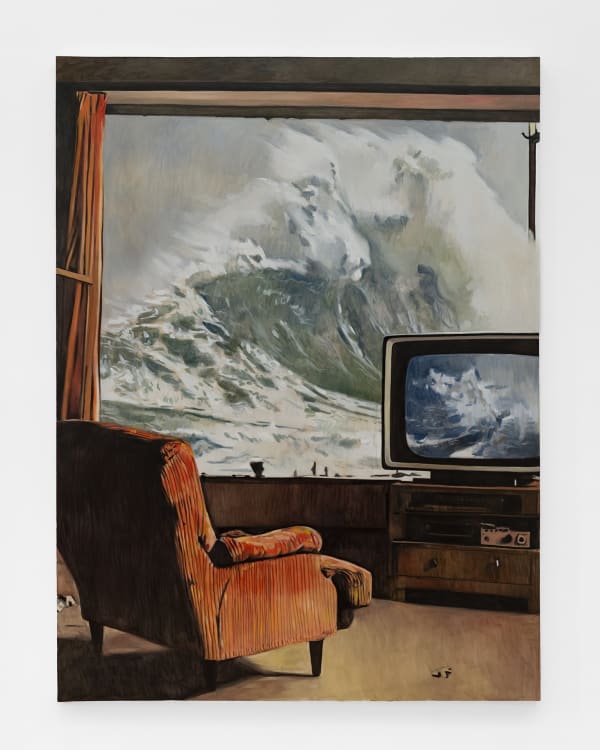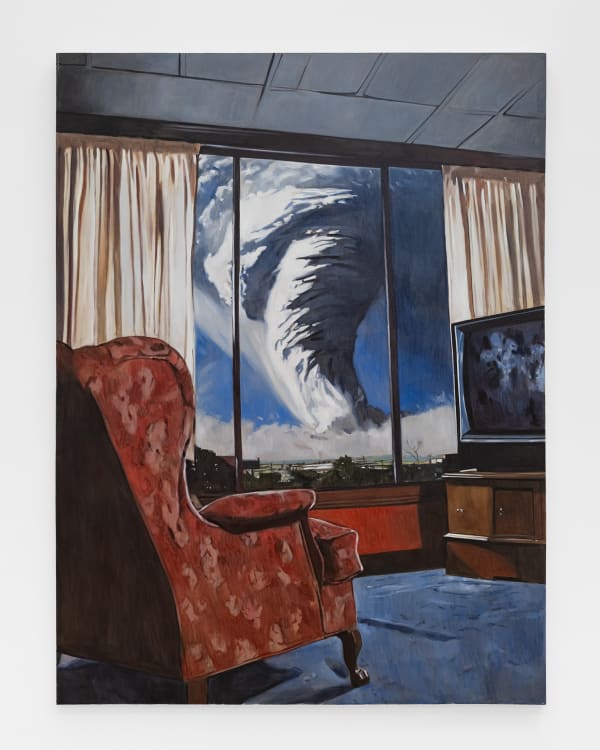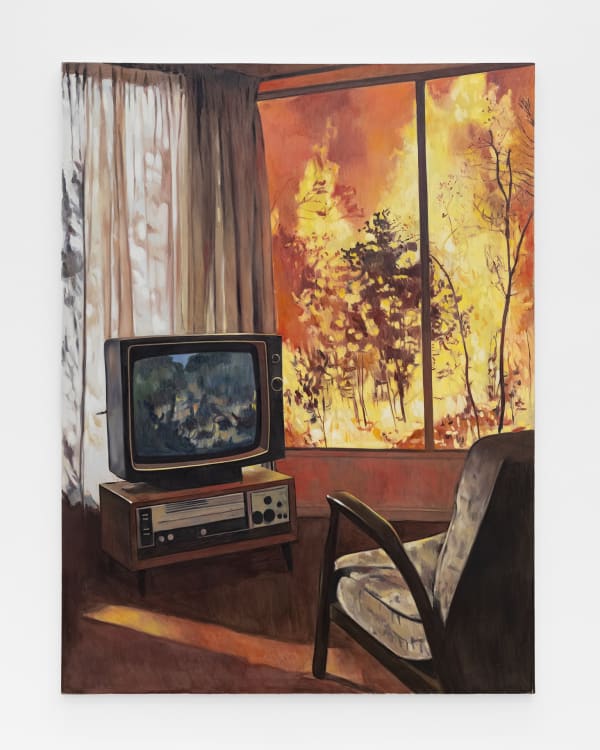-
Works
-
 Oliver CleggA horse is a horse/Of course of course!, 2024Oil on linen80 x 60 in (203.2 x 152.4 cm)
Oliver CleggA horse is a horse/Of course of course!, 2024Oil on linen80 x 60 in (203.2 x 152.4 cm) -
 Oliver CleggNothin’ to see here, 2024Oil on linen80 x 60 in (203.2 x 152.4 cm)
Oliver CleggNothin’ to see here, 2024Oil on linen80 x 60 in (203.2 x 152.4 cm) -
 Oliver Clegground n round n up n down we go again, 2024Oil on linen80 x 60 in (203.2 x 152.4 cm)
Oliver Clegground n round n up n down we go again, 2024Oil on linen80 x 60 in (203.2 x 152.4 cm) -
 Oliver Clegg“Do you ever get anywhere?” - he asked with a mocking laugh, 2024Oil on linen80 x 60 in (203.2 x 152.4 cm)
Oliver Clegg“Do you ever get anywhere?” - he asked with a mocking laugh, 2024Oil on linen80 x 60 in (203.2 x 152.4 cm)
-
-
Biography

-
Installation Views
-
Q&A
Your name Oliver CleggYour occupation PainterYour favorite pastime Making my children laughSomething you like Chocolate eclairsSomething you dislike LiquoriceYour defining characteristic My legsWhat would someone close to you say your defining characteristic is My inability to concentrate on anything importantYour favorite artist Christoph BuchelFavorite word or phrase ChuffedWhat aspect of your work is most important to you Making a painting feel proud to be a painting :/Who do you admire the most and why Sky and Stella (2 of our dogs) -they are always happy to see youYour worst habit LazinessThe first thing you think of in the morning WaterWhat have you always wanted to do and have not done Go to IndiaYour best decision Learning to surfYour worst decision Starting too lateYour favorite street Atlantic Terrace, Cornwall, UK. Unrivalled peace and beautyWhat made you become the person you are My motherSomething that you treasure My familyWhat would the child you once were think of the adult you have become He would be impessed that I managed to never grow up.Your greatest fear Heights -
Text
What are Oliver Clegg's new paintings about?
You might think you know—after all, they don’t seem subtle. Large tableaux in oil on linen, each depicts a clever dichotomy, a world in two parts. The first is a terrifying natural disaster happening in real time just outside out a picture window. The second is another natural disaster—the tranquil interior from which the catastrophe is glimpsed, with a chair angle to a television set playing a far more sylvan scene. In one, a raging forest fire outside outset is countered by a lovely woodsy program onscreen. In another, a massive, looming, breaking tsunami wave is contrasted by a surfer-friendly wave on the TV set.
So, surely, Clegg’s new works mirror the world we live in. With the exception of a stampede of wild horses (offset on TV with a scene of horses calmly grazing), the catastrophes outside all refer to tales of climate change—oceans flooding, superstorms swirling, wildfires blazing, ripping now-sadly-familiar swaths of destruction through modern reality. And with beautifully rendered, painstaking photorealistic style suggesting modern reality; overtones of Caravaggio-esque chiaroscuro suggesting heightened melodrama ; and 60s-ranch-house interiors and TV sets suggesting an ironic American detachment, the paintings seem a blithe but biting comment on the climate and future denialism that so defines our time.
Or…. could Clegg be depicting an even more exact moment in time? Unveiled on the eve of Halloween and the 2024 election, maybe they are about the catastrophe that a second Trump presidency could set off, contrasted by the cavalier way his followers wave off such serious issues as though it was just happening on a bingeable new Netflix series.
But actually, for the artist, as pointed and timely as the works seem to be, the vision they conjure and the duality they set up is much more profound than something happening outside today. They’re attempting to get at something more primal and central to human existence as well as to the artist’s process. The dangers downplaying climate change and dictatorship may be painfully present, but they are just the tip of the iceberg. A hugely underestimated part of human consciousness is the invisible yet pervasive process of taking frighteningly unimaginable reality and condensing it down to something bite size that doesn’t bite. It’s how we make sense of life.
And for Clegg, this process of refinement is what making art is about, taking the fantastic and making it quotidian, the stuff of everyday life instead of everyday overwhelm—which, interestingly, is in many ways the opposite of the great model of art as something ordinary rendered fantastic.
An escapee from modern supersaturated culture, the British-born, Italian-educated former New Yorker now lives in remote, rural Costa Rica, about as far from as climate/election panic as he can get. For him, his paintings are about that physical, emotional and psychological stripping back of the incursions of the world and creating his own secure world, like the garden Candide ultimately decides chooses to cultivate. Out of noise, he creates a melody.
In the end, the show’s four large canvases are a potent illustration that condensing, massaging and defanging reality to give you a sense of security isn’t something that “they” do. We all do it, every hour of every day. It’s as crucial to survival and thriving as food and shelter.
Some may call it denial—but what is denial but hope stripped bare?
David Colman
-
Artist






